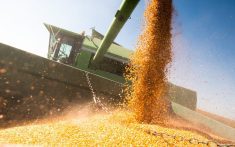Chicago | Reuters – U.S. wheat, soybean and corn futures soared to multi-month highs on Monday on worries about potentially crop-damaging weather in Brazil and Russia.
Chicago Board of Trade (CBOT) July wheat WN24 settled up 26-1/4 cents at $6.48-3/4 a bushel after climbing to $6.50-1/4, its highest level since late December.
CBOT July corn CN24 ended up 8-3/4 cents at $4.69 a bushel, having reached its highest point since January, and July soybeans SN24 climbed 33-3/4 cents to finish at $12.48-3/4 a bushel, also reaching a four-month peak.
Read Also

U.S. grains: Soy futures dip as traders await China sales; corn, wheat sag
U.S. soybean futures retreated on Monday from a one-week top on a lack of fresh soy sales to top buyer China and lingering doubts over whether the Asian nation will buy 12 million tonnes of the oilseed by the end of 2025
Wheat’s rise was driven by volatile weather conditions in Russia, including dryness in the south of the country and May frosts in some areas.
Consultancy IKAR cut its forecast for the world’s largest wheat exporter last week.
Meanwhile, the outlook for the soybean harvest in Brazil’s Rio Grande do Sul state is deteriorating after torrential rains flooded fields, with about a quarter of beans left to harvest. The deluge may also reduce the state’s corn volumes and further clip South American supply after downgrades to estimates of Argentina’s crop.
Grain traders were monitoring corn and soybean planting progress in the U.S. Midwest amid bouts of adverse weather, said Bill Lapp, president of Advanced Economic Solutions.
Volatile weather stories were prompting fund activity, analysts said.
“We’re starting to see the funds over the last few weeks start to flip out of their commodity deflation mode that they’ve been in for the last two years,” said Arlan Suderman, chief commodities economist at StoneX.
“There were fundamental stories that were being ignored before that suddenly that markets are paying attention to,” Suderman added.
After the CBOT close, the U.S. Department of Agriculture said the U.S. corn crop was 36 per cent planted by Sunday, behind an average of trade expectations and lagging the five-year average of 39 per cent. The USDA pegged soybean planting as 25 per cent complete, behind trade expectations but still ahead of the five-year average of 21 per cent.
The government rated 50 per cent. of the U.S. winter wheat crop in good to excellent condition, up from 49 per cent. a week ago, while the U.S. spring wheat crop was 47 per cent planted, well ahead of the five-year average of 31 per cent.
– Additional reporting by Gus Trompiz in Paris and Naveen Thukral in Singapore















